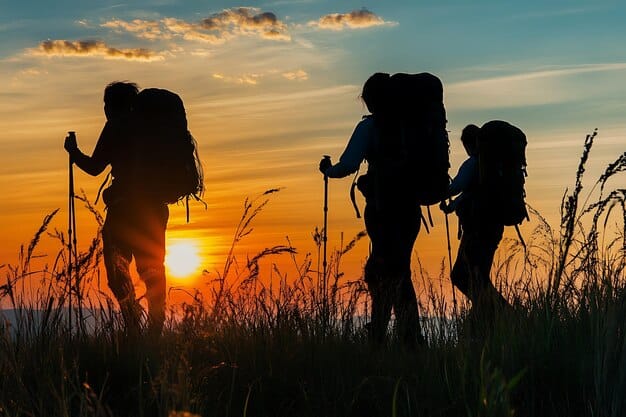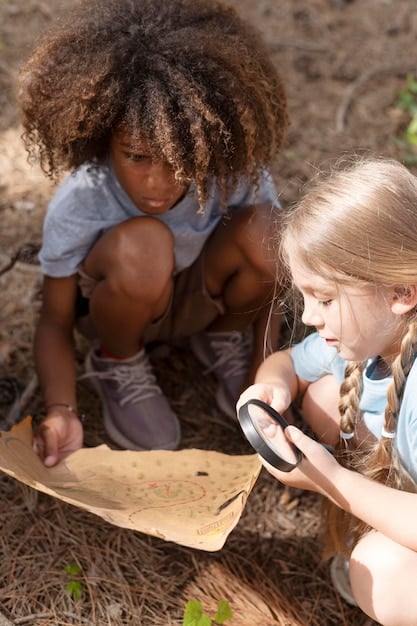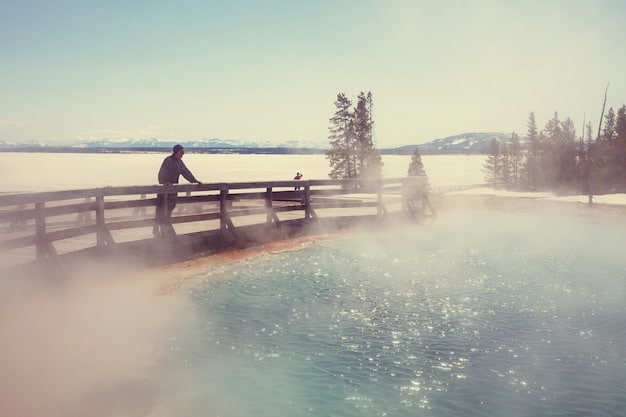Maximize Your Family’s National Park Visit in 2025: Insider Tips

Maximize Your Family’s National Park Visit in 2025: Insider Tips for a 20% More Enjoyable Experience by planning ahead, choosing the right park, engaging in educational activities, prioritizing safety, and packing strategically to ensure a memorable and stress-free adventure.
Planning a family trip to a national park in 2025? You’re in for an adventure! But to truly make it unforgettable, a bit of insider knowledge can go a long way. This guide, “Maximize Your Family’s National Park Visit in 2025: Insider Tips for a 20% More Enjoyable Experience,” will equip you with the best strategies for a seamless and enriching experience for everyone.
Planning Your Trip: Timing is Everything
The key to a successful national park visit begins long before you set foot on the trail. Careful planning, especially regarding timing, can dramatically impact your experience. Consider the seasons, weather patterns, and holiday crowds when deciding on your travel dates.
Seasonal Considerations
Each season offers a unique perspective of the national parks. Summer brings warm weather and accessibility to most areas but also the largest crowds. Spring and fall offer milder temperatures and fewer visitors, while winter can provide stunning snow-covered landscapes, but with limited access to certain regions.
Weather Patterns and Park Accessibility
National parks span diverse climates, from the arid deserts of the Southwest to the temperate rainforests of the Pacific Northwest. Research the typical weather conditions for your chosen park during your travel dates. Check for road closures, trail conditions, and potential hazards like flash floods or wildfires.
- Check the Park’s Website: Official park websites provide up-to-date information on weather alerts, road closures, and trail conditions.
- Consider Shoulder Seasons: Traveling in the spring or fall often means fewer crowds and pleasant temperatures.
- Pack for All Conditions: Even in summer, mountain weather can change rapidly, so bring layers and rain gear.
By carefully considering the timing of your visit, you can avoid the worst crowds, enjoy more pleasant weather, and ensure greater access to the park’s attractions. This foresight sets the stage for a smoother and more enjoyable family experience.
Choosing the Right Park for Your Family
With over 60 national parks in the United States, selecting the perfect one for your family can feel overwhelming. Consider your family’s interests, ages, and physical abilities when making your decision. Not all parks are created equal, and some will be a better fit for your family than others.

Assessing Your Family’s Interests and Abilities
Does your family enjoy hiking, wildlife viewing, historical sites, or water activities? Some parks are renowned for their challenging hikes, while others offer accessible trails and engaging ranger programs. Consider the ages and physical abilities of your family members to ensure everyone can participate and enjoy the activities.
Researching Park Activities and Amenities
Once you have a general idea of what you’re looking for, research the available activities and amenities at potential parks. Do they offer guided tours, visitor centers, campgrounds, or lodging options? Check for specific family-friendly programs like Junior Ranger programs or nature walks geared toward children.
- Consider Park Size: Larger parks require more travel time between attractions, so plan accordingly.
- Read Reviews: Online reviews from other families can provide valuable insights into the park’s suitability for children.
- Look for Accessible Options: Many parks offer accessible trails, exhibits, and programs for visitors with disabilities.
Choosing the right park is crucial for a positive family experience. By carefully considering your family’s interests, abilities, and the park’s offerings, you can ensure a memorable and enjoyable adventure.
Engaging in Educational Activities
National parks are more than just scenic landscapes; they are living classrooms. Take advantage of the educational opportunities available to enrich your family’s experience and foster a deeper appreciation for the natural world. Engaging in these activities can make the trip more meaningful and memorable.
Participating in Ranger-Led Programs
Ranger-led programs are a fantastic way to learn about the park’s history, ecology, and geology. These programs often include guided hikes, campfire talks, and demonstrations. Check the park’s schedule for program times and locations.
Completing the Junior Ranger Program
The Junior Ranger program is a fun and educational activity for children. Kids can earn a badge by completing activities in a booklet, attending ranger programs, and learning about the park’s resources. This program encourages exploration and stewardship.

- Visit Visitor Centers: Visitor centers provide exhibits, films, and information about the park’s resources.
- Download the Park’s App: Many parks have apps with maps, audio tours, and interactive activities.
- Read Books and Guides: Prepare for your trip by reading books and guides about the park’s history and natural features.
Engaging in educational activities transforms a family vacation into a learning experience. By participating in ranger programs, completing the Junior Ranger program, and exploring visitor centers, your family can gain a deeper understanding and appreciation for the wonders of the national parks.
Prioritizing Safety and Preparedness
Ensuring the safety and well-being of your family is paramount when visiting a national park. Being prepared for potential hazards and following safety guidelines can prevent accidents and ensure a more enjoyable experience. A little planning can make a big difference.
Understanding Potential Hazards
National parks can present various hazards, including wildlife encounters, extreme weather, and challenging terrain. Be aware of the potential risks in your chosen park and take precautions to mitigate them. This includes understanding how to react to wildlife encounters, staying hydrated, and avoiding strenuous activities in extreme heat.
Following Safety Guidelines and Regulations
Parks have specific guidelines and regulations to protect visitors and preserve the natural environment. Familiarize yourself with these rules and follow them diligently. Stay on marked trails, avoid feeding wildlife, and properly store food to prevent attracting animals to your campsite.
- Carry a First-Aid Kit: Include essential supplies like bandages, antiseptic wipes, pain relievers, and insect repellent.
- Inform Someone of Your Plans: Let a friend or family member know your itinerary and expected return time.
- Bring a Map and Compass: Even with GPS, a map and compass can be invaluable in case of electronic failure.
Prioritizing safety and preparedness is essential for a successful national park visit. Educating yourself about potential hazards, following safety guidelines, and packing appropriate supplies can minimize risks and ensure a memorable and safe family adventure.
Packing Strategically for Comfort and Convenience
Packing efficiently and strategically can significantly enhance your comfort and convenience during your national park visit. Consider the climate, activities, and duration of your trip when selecting your gear. The right gear can make all the difference in enjoying your trip.
Choosing the Right Clothing and Footwear
Dress in layers to adapt to changing weather conditions. Opt for moisture-wicking fabrics that dry quickly and provide insulation. Comfortable and sturdy hiking shoes are essential for exploring trails. Don’t forget rain gear, hats, and sunscreen to protect yourself from the elements.
Bringing Essential Gear and Supplies
Pack essential gear such as a first-aid kit, map, compass, flashlight, and multi-tool. Bring plenty of water and snacks to stay hydrated and energized. Consider a portable charger for your electronic devices. Binoculars can enhance wildlife viewing, and a camera will help you capture memorable moments.
- Use Packing Cubes: These organizers keep your belongings tidy and compressed.
- Roll Your Clothes: Rolling saves space and minimizes wrinkles.
- Weigh Your Pack: Distribute the weight evenly and avoid overloading your backpack.
Strategic packing ensures you have everything you need for a comfortable and enjoyable national park adventure. By selecting the right clothing, gear, and supplies, you can minimize discomfort and maximize your time exploring the park’s wonders.
Ensuring a Sustainable and Respectful Visit
As visitors to these natural treasures, it is our responsibility to minimize our impact on the environment and respect the local ecosystem. Practicing sustainable and responsible travel habits ensures that future generations can enjoy these parks as we do.
Practicing Leave No Trace Principles
The Leave No Trace principles are guidelines for minimizing your impact on the environment. These principles include packing out all trash, staying on designated trails, minimizing campfire impacts, respecting wildlife, and leaving natural objects undisturbed.
Respecting Wildlife and Their Habitat
Observe wildlife from a safe distance and never feed them. Feeding wildlife can alter their natural behaviors and make them dependent on human food. Keep a safe distance, store food properly, and avoid approaching or harassing animals.
- Use Reusable Water Bottles: Reduce plastic waste by bringing a reusable water bottle and refilling it at water stations.
- Support Local Businesses: Shop at local stores and eat at local restaurants to support the park’s economy.
- Educate Others: Share your knowledge and encourage others to practice sustainable travel habits.
By adopting sustainable travel habits, we can help protect the natural beauty and ecological integrity of these parks for generations to come. Respecting wildlife, leaving no trace, and supporting local businesses are essential components of responsible park visitation.
| Key Aspect | Brief Description |
|---|---|
| 🗓️ Plan Ahead | Choose the best time to visit, considering weather and crowds. |
| 👨👩👧👦 Right Park | Select a park that matches your family’s interests and abilities. |
| 🎒 Pack Smart | Bring essential gear for safety, comfort, and convenience. |
| 🌿 Be Sustainable | Practice responsible travel habits to protect the environment. |
Frequently Asked Questions
▼
The best time to visit varies by park. Generally, spring and fall offer pleasant weather and fewer crowds. Summer is popular but can be crowded and hot. Winter provides unique experiences in some parks.
▼
Consider purchasing an annual America the Beautiful Pass for park entry. Camp instead of staying in lodging, and bring your own food and drinks to avoid expensive park concessions.
▼
Maintain a safe distance and never feed wildlife. Store food properly and be aware of your surroundings. If an animal approaches, make yourself look large and make noise to scare it away.
▼
Many national parks offer accessible trails, exhibits, and programs. Check the park’s website for information on accessibility options and resources for visitors with disabilities.
▼
Practice Leave No Trace principles by packing out all trash, staying on marked trails, and avoiding disturbing wildlife. Use reusable water bottles and support local businesses to minimize your impact.
Conclusion
By following these insider tips, you can maximize your family’s national park visit in 2025 and create unforgettable memories. Planning ahead, choosing the right park, engaging in educational activities, prioritizing safety, packing strategically, and ensuring a sustainable visit will contribute to a richer and more enjoyable experience for everyone involved.





